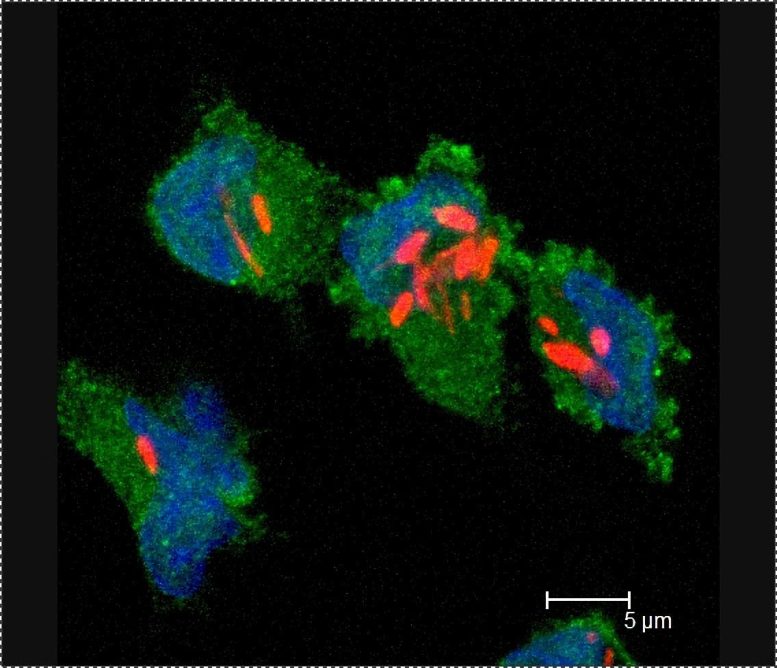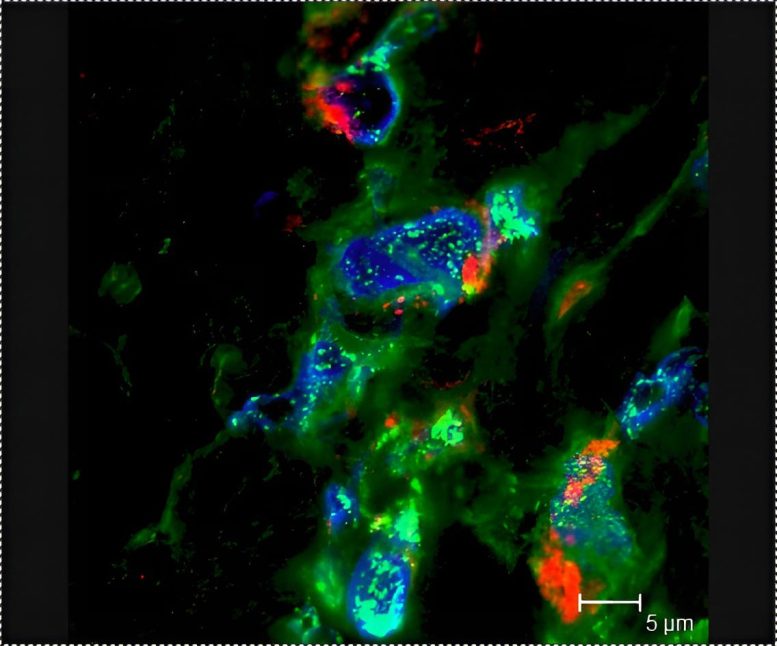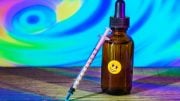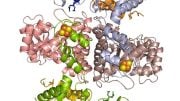
This shows macrophages infected with the leprosy bacterium, M. leprae, in vitro. The nucleus is blue. Credit: University of California – Los Angeles
A new study from UCLA suggests that certain bacteria can pretend to be viruses when infecting humans, allowing them to hijack the body’s immune response so that they can hide inside cells.
An outbreak of tuberculosis in the Skid Row area of downtown Los Angeles may have exposed up to 4,500 individuals to the bacterium that causes the deadly disease and has left federal officials scrambling to intervene.
The outbreak is occurring during winter, when homeless individuals are driven to crowded shelters, when influenza is peaking, and when people’s vitamin D levels, typically boosted by sunlight exposure, are low. A new University of California, Los Angeles (UCLA) study offers critical insight into how various bacteria may manipulate such factors to their advantage.
In a study published online on February 28 in the journal Science, UCLA researchers demonstrate that certain cunning bacteria — including the type that causes tuberculosis — can pretend to be viruses when infecting humans, allowing them to hijack the body’s immune response so that they can hide out, unhindered, inside our cells. The findings may also help explain how viral infections like the flu make us more susceptible to subsequent bacterial infections such as pneumonia.

This shows M. leprae (red) and IFN-beta (green) in cells in a leprosy lesion. The nucleus is blue. Credit: University of California – Los Angeles Health Sciences
The study is particularly relevant to tuberculosis, which kills 1.4 million people worldwide each year. In the case of the recent Los Angeles outbreak, the findings could provide clues as to how the flu and a lack of vitamin D may have given the tuberculosis bacterium an edge.
“With 8.7 million in the world falling ill with tuberculosis each year, a better understanding of how these bacteria avoid our immune system could lead to new ways to fight them and to better, more targeted treatments,” said senior author Dr. Robert L. Modlin, chief of dermatology at the David Geffen School of Medicine at UCLA and a professor of microbiology, immunology, and molecular genetics in the UCLA Division of Life Sciences.
The protection our immune system provides against bacteria-based diseases and infections depends on the critical response of T cells — white blood cells that play a central role in fighting infections — and in particular on the release of a protein called interferon-gamma. Interferon-gamma utilizes the vitamin D hormone to alert and activate cells to destroy invading bacteria.
The research team found that bacteria can pretend to be viruses, triggering the immune system to launch an attack with a different protein, called interferon-beta, which is designed to fight viruses, not bacteria. Not only is interferon-beta ineffective against bacteria, but it can also block the action of interferon-gamma, to the advantage of bacteria. Further, if a real virus were to infect the body, triggering interferon-beta, it would divert the attention of the immune response, preventing an attack on the bacterial invader. The researchers say this may explain why the flu can lead to a more serious bacteria-based infection like pneumonia.
“Like a wolf in sheep’s clothing, the bacteria can fool the immune system into launching an attack against the wrong type of infection, thus weakening the response against the bacteria,” said first author Rosane M. B. Teles, a researcher in the dermatology division at the Geffen School of Medicine.
For the study, the team examined the mechanisms by which the virus-fighting interferon-beta protein suppresses the interferon-gamma defense response to bacterial infections, tricking the immune system into making the wrong defense choices.
The researchers studied leprosy as a model and then applied what they learned to understand tuberculosis, given that leprosy and tuberculosis are caused by related bacteria. Modlin noted that leprosy is an outstanding model for studying immune mechanisms in host defense since it presents as a clinical spectrum that correlates with the level and type of immune response of the pathogen.
The scientists first compared the genetic expression of the virus-fighting interferon-beta protein and the bacteria-fighting interferon-gamma protein in skin lesions from leprosy patients. They found that interferon-gamma was expressed in patients with the milder form of the disease and that interferon-beta was significantly increased in those with the more serious, progressive form of leprosy.
The researchers then compared the genes triggered by interferon-beta in these leprosy skin lesions with those found by two other groups of investigators in the blood of tuberculosis patients. Remarkably, there was a significant overlap. The interferon-beta genes were more frequent in both the skin lesions of leprosy patients with extensive disease and the blood of tuberculosis patients with more severe disease.
“We found this common interferon-beta gene pattern correlated with the greater extent of disease in both leprosy and tuberculosis, which are two very distinct diseases,” Teles said.
Previous work by the UCLA team demonstrated that the interferon-gamma defense pathway relies on a specific mechanism involving vitamin D, a natural hormone that plays an essential role in the body’s fight against infections. The current study found that interferon-beta suppressed elements involved in the interferon-gamma–triggered vitamin D pathway, preventing the immune system from killing the bacteria.
“The study raises the possibility that a decrease or increase of one of these two interferon proteins could shift the balance from mild to more serious disease,” Modlin said. “We may find that therapeutic interventions to block or enhance specific interferon responses may be an effective strategy to alter the balance in favor of protection against bacterial diseases.”
The new findings may indicate why, in winter, Los Angeles skid row residents are at an added disadvantage in dealing with tuberculosis — for at least three reasons. First, because of colder weather at night, indigent homeless people tend to stay in shelters, where they live in close proximity with others, facilitating the spread of the infection. Second, due to the seasonal rise in influenza, the body’s immune system could be diverted by the flu virus to produce interferon-beta, blocking an effective immune response to the tuberculosis bacteria. And finally, the drop in vitamin D levels associated with a decrease in exposure to sunlight during the winter months could diminish the ability of individuals’ immune systems to kill the tuberculosis bacteria.
“With TB on the rise, this scenario could play out not only in cities in the United States but all over the world,” Modlin said. “We hope that our findings may provide insight into harnessing new methods to combat TB and other bacterial infections as well.”
Modlin noted that 8.7 million people become ill with tuberculosis each year and 1.4 million die from the disease. He said that an increase or decrease in one of the two interferon proteins could help explain why some people may be more resilient against, or susceptible to, the infection or have a more serious course of the disease.
The next step, according to Teles, is to further understand the mechanisms that bacterial pathogens use to activate interferon-beta and how bacteria can manipulate the immune system to block the potent interferon-gamma host antimicrobial responses in human infections.
Reference: “Type I Interferon Suppresses Type II Interferon–Triggered Human Anti-Mycobacterial Responses” by Rosane M. B. Teles, Thomas G. Graeber, Stephan R. Krutzik, Dennis Montoya, Mirjam Schenk, Delphine J. Lee, Evangelia Komisopoulou, Kindra Kelly-Scumpia, Rene Chun, Shankar S. Iyer, Euzenir N. Sarno, Thomas H. Rea, Martin Hewison, John S. Adams, Stephen J. Popper, David A. Relman, Steffen Stenger, Barry R. Bloom, Genhong Cheng and Robert L. Modlin, 28 February 2013, Science.
DOI: 10.1126/science.1233665
The study was funded by the National Institute of Arthritis and Musculoskeletal Skin Diseases, part of the National Institutes of Health (NIH P50; ARO63020; RO1s AI022553, AR040312 and AI047868; and CTSA Grant UL1TR000124).









It is only survival game that is going on everywhere. There is an article stating that virus overcomes bacteria’s defense mechanism for gaining its entry. Similarly Bacteria develops defense mechanism from attacking T cells and other anti-biotic discovered by mankind. The ladder for fight and counter-fight is growing taller and taller for bacteria and mankind. After all bacteria were the first occupant of this earth and we came later to occupy its space and surroundings. But they will live longer than mankind inhabiting the earth in future also. Hence it only calls for man’s survival against them in the long run to discover more and more defense tools for them. Thank You.
These wallless bacteria mycoplasmas are the stealth actors of all time.
Imagine being able to hide within the cells and be completely undetectable.
Leprosy, tb, and many others are the result.
Hopefully the world conference on mycoplasma in Toulouse France this year will produce much more information.